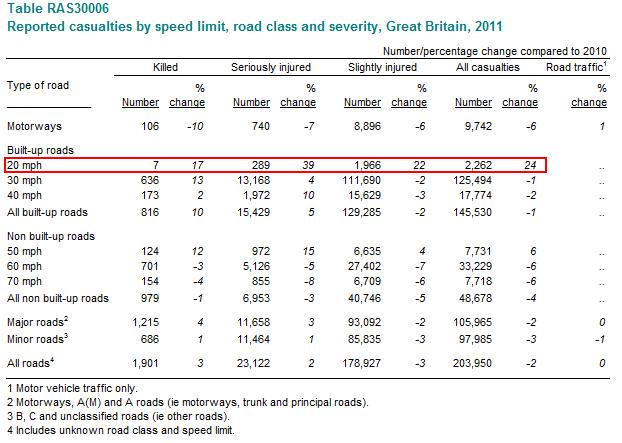Is the jury still out on 20 mph zones?
Over the weekend the Sun, BBC and others reported on recently released road accident statistics from the Department for Transport (DfT). Their headlines made for grim reading:
"CONTROVERSIAL 20mph speed limits designed to cut road casualties are not working, official figures show."
The Sun, 11 August 2012
The Sun's report confidently concluded the figures showed that 20 mph speed limits were not working. So do the figures really show this?
The reports made use of DfT figures on 'Reported casualties by speed limit, road class and severity, Great Britain, 2011'. At first glance, it isn't difficult to see the point the reports are making:

The 24 per cent rise in all casulaties on 20 mph roads is noticeably different from the change in all other road types, most of which saw a slight fall in casualty numbers. This is actually consistent with a trend going back to at least 2007:

However the Department for Transport provides no explanation for the anomalous rise in 20 mph road casualties, nor those in previous years. So can we conclude anything from this data at all?
Unfortunately, while the data certainly exposes large increases in casualties on 20 mph roads, it doesn't tell us anything about how many of these roads actually exist in the UK, and how their number has changed.
If recent years had seen a rapid expansion in the number of 20mph zones in use across the country, we might expect to see more casualties on these streets simply because they are more widely used by motorists.
In other words, we don't know what the casualty rate is as a proportion of either the number of 20mph roads, the number of people using them or their total length. As we've seen in the past, road safety data is usually understood through this prism.
A quick call to the DfT's road accident statistics team confirmed that no data exists on the number of roads operating a 20 mph or any other speed limit, although acquiring such estimates was something they were "looking into".
However, there is some evidence to suggest that the number of 20 mph roads is likely to be increasing. A recent briefing paper from the House of Commons Library provides an outline of recent and past policy changes to 20 mph limits and their implementation.
It cites a 2006 guidance paper on 20 mph limits and zones from the DfT, which highlighted that:
"Many traffic authorities are now implementing 20 mph zones and 20 mph speed limits, and this is encouraged and supported by the Department."
The briefing paper also charts a general relaxing of restrictions to local authorities that wish to implement 20 mph limits over the last decade and a half, as well as a changing emphasis in government rhetoric towards encouraging more such limits and zones to be introduced.
The Government also announced in 2009 it would expand the use of 20 mph zones. The Coalition looks set to continue this trend, setting out in 2011 that:
"We plan to revise and reissue the guidance on speed limits in urban areas with the aim of increasing flexibility for local authorities."
So whether or not we can be sure the number of roads with 20 mph limits is on the rise already, we might expect that increased flexibility for local authorities to convert existing 30 mph roads to 20 mph would have some upward effect on their total number.
Unfortunately for the time being there is no sound data on how widely used 20 mph zones or limits are, and the casualty statistics commented upon over the weekend don't tell us a great deal without this information.
Those readers looking for an informed understanding on how effective 20 mph speed limits and zones are might therefore wish to take a look at the evidence that is available on their impact upon road safety before jumping to conclusions.